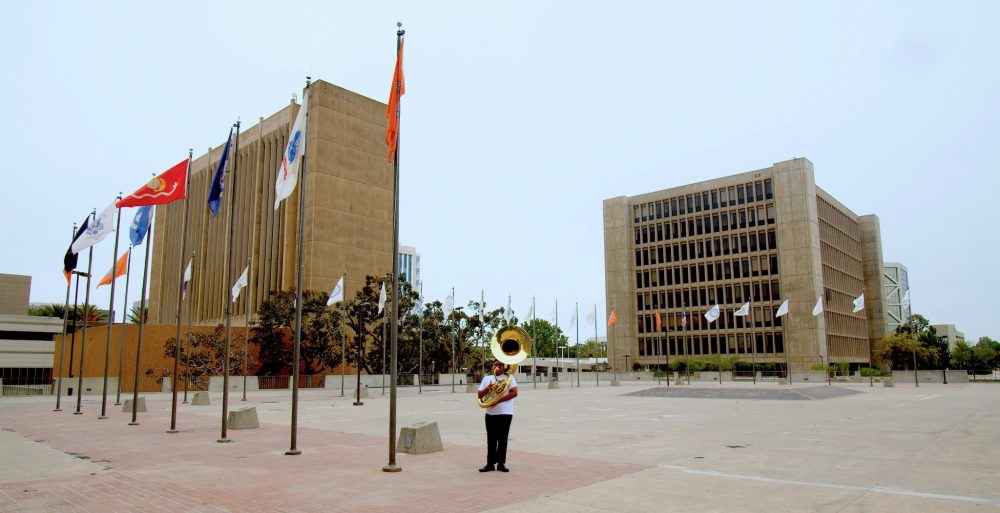Susy Bielak and Fred Schmalz: Welcome

October 7, 2023 – January 14, 2024
Performances
Saturday, October 7, 7:30PM, 8:00PM, 8:30PM
Students and Music Director Ammy Beltran of Valley High School
Welcome centers the limits of welcome, including the social structures that determine who is welcome and under what circumstances it may be rescinded, curtailed, or abandoned. Welcome responds to contemporary and historical acts of social and environmental control in Orange County—including plant hybridization, civic regulation, labor, immigration, the uses of public space, and property division. Through video, painting, sculpture, text, and sound, the works highlight how unwelcome coexists with joy and inclusion in Southern California.
Welcome draws upon four years of site visits, archival research, conversation and collaboration with activists, educators, and urban planners into Orange County’s development and contemporary culture. This experience revealed a palimpsest of colonialism, migration, militarization, white nationalism, resistance, and resilience.
The exhibition’s largest installation, Hybrid, is inspired by the region’s history of crop science and attempts to control nature. The image of an orange blossom being hybridized—embedded into an AstroTurf hillside—evokes the pervasive idealization of nature in Orange County, even as the area has become increasingly developed and suburbanized.
Two video works examine the complexities of public spaces in the region. In Mosquito/Xeno, tubist Abraham Hernandez stands alone in Orange County’s civic center plaza playing his composition, Xeno, as an act of joy and defiance that beckons neighbors to join him. Fruit Drop recreates—in McFadden Institute of Technology’s outdoor “Theatron”—the drought-condition phenomenon where citrus plants shed their fruit.
Three paintings in illuminated frames reveal layers of the region’s histories. Restricted Area references the intersection of migration and militarization in the region, with a recently arrived Vietnamese refugee standing behind a sign (printed in two colonial languages, but not his own) at a military base. Field highlights the region’s economic foundations in agriculture—an era when migration that was frequently met with resistance, including in the internment of Japanese-American farmers during World War II. Fumigation reveals the extent of ranch owners’ often-toxic interventions into the environment to make food production profitable. These works, glowing in their windows—designed to evoke television sets and the Santa Ana train station’s windows—are installed behind a suburban privacy fence.
In the sound installations Never Never and Am I an American, Valley High School choir students reimagine a chant from a 1970s fair housing protest and a question printed on a 1920s KKK recruitment flier. These works respectively reference the struggle for equality and the history of the building where Grand Central Art Center currently resides.
The infographic poem Three Conditional Welcomes intervenes upon the initial planning documents for the University of California, Irvine. The campus, which preceded the city, was composed of isolated clusters. The buildings’ entrance doors face away from the circular meadow at the campus’ core. The school’s first employee, responsible for the campus’ construction, was a defense contractor. The text of Three Conditional Welcomes references Orange County histories of restrictive housing covenants, segregation, refugee encampments, infrastructural deterrents to communities, and the ways urban development can distance people from their landscapes.
About the Artists
The ongoing collaborative art practice of Susy Bielak and Fred Schmalz mines social histories, texts and archives—using poetry, ethnography, and multimedia production to create writing, installations, performances, and public works. Their work synthesizes the poetic, social, and political terrain of urban locales into installations and actions that reflect the gravity and strangeness of contemporary cities. The duo’s recent work has been staged at the Museum of Contemporary Art Chicago and in Eighth Blackbird’s Chicago Artists Workshop series.
Susy Bielak is an artist, writer, curator, and educator. Her work responds to issues including migration, displacement, and disaster. Her projects have ranged from town hall meetings to drawings made with her breath. Collaborators have included rodeo cowboys, bus drivers, a veteran barbershop quartet, choreographers, and engineers. Her work has been collected and exhibited widely, including by the International Print Center, Museo Tamayo, San Diego Museum of Contemporary Art, and Walker Art Center. She received an MFA from the University of California San Diego.
Fred Schmalz is an artist, writer, and editor. He is the author of Action in the Orchards (Nightboat Books 2019), which explores intimacy and loss via encounters with contemporary art. His current writing examines the sanctioning of violence in American culture and how displays of militarism and force are countered by acts of care. His recent writing has appeared in Puerto del Sol, Tyger Quarterly, The Canary, Poetry, Typo, guesthouse, and Oversound. He received an MFA in prose and poetry from Northwestern University.
Artist Acknowledgements
We thank Grand Central Art Center for our residency and commissioning this exhibition, as well as for fostering so many community connections and conversations. We thank the McFadden Institute of Technology, Santa Ana Unified School District, Valley High School Music, and the University of California, Irvine Archives for their support and partnership.
GCAC also wishes to thank Chemers Gallery in Tustin for their in-kind support, especially Karen and Ryan.